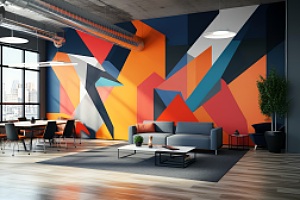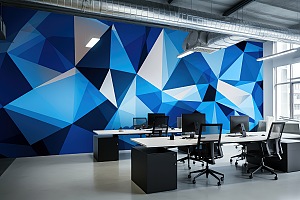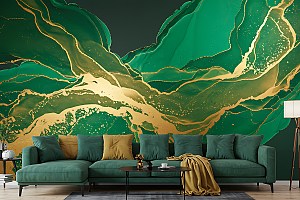A room’s aesthetic extends beyond the furniture and decorations. The walls are some of a space’s largest available square footage, but many home and business owners fail to leverage them for their true potential. To make the most of a room’s walls, consider covering them with colors, pictures, or patterns that complement the rest of the décor. Both traditional wallpaper and digital wall coverings can help with this, but there are some important differences to consider.
Digital wall coverings are increasingly popular, and for good reason. They tackle some of the challenges that wallpaper struggles to overcome, but anyone redecorating their space must understand each option’s strengths, weaknesses, and primary distinctions.
What Are Digital Wall Coverings?
 Digital wall coverings are wall décor that, like wallpaper, adhere directly to a wall. They use high-fidelity advanced printing techniques to create custom designs or patterns. Digital wall coverings can even be textured, adding a host of compelling choices for your interior.
Digital wall coverings are wall décor that, like wallpaper, adhere directly to a wall. They use high-fidelity advanced printing techniques to create custom designs or patterns. Digital wall coverings can even be textured, adding a host of compelling choices for your interior.
This type of wall décor is attached directly to the wall, but it can be removed later. Custom options are available thanks to the specialized printer, which can handle a wide range of designs and patterns.
What Is Traditional Wallpaper?
Traditional wallpaper has been around for a long time. This classic is applied directly to walls and adheres using special wallpaper glue. It tends to be one of the most affordable décor options, boasting an array of colors and patterns. Wallpaper can be made from a variety of materials, but the most common are paper, fabric, and natural fibers.
Differences, Similarities, Pros, and Cons
Both digital wall coverings and wallpaper perform the basic task of covering a wall’s surface. However, they are not the same, and in fact, they differ substantially in a handful of important areas:
Digital wall coverings
- Printing: Digital wall coverings are printed using a high-tech printer that accepts high-fidelity digital images. This means that the resulting wall covering can display remarkably complex pictures or patterns in rich colors.
 Installation: Digital coverings adhere to the wall, but they are not glued on with thick adhesive. This application makes them simple to remove later and even allows for rooms to intentionally plan temporary aesthetics that change over time.
Installation: Digital coverings adhere to the wall, but they are not glued on with thick adhesive. This application makes them simple to remove later and even allows for rooms to intentionally plan temporary aesthetics that change over time.- Texture: Textured options are available among digital wall coverings, allowing for visual interest and even noise reduction. Due to the specialized printers used, wall coverings can replicate even intricate textures, such as brick.
- Longevity: Digital wall coverings are made from thick, premium materials that stand the test of time. Most wall coverings are vinyl-based, making them resistant to spills, stains, and blunt force. They are also easy to wash (usually just a quick wipe-down with a damp cloth), so they can serve as a bright focal point in any room for years.
- Price: Digital wall décor is an affordable option, especially when used in place of materials such as stone or brick. The additional customization does not significantly impact the price, so users are encouraged to choose a design that aligns with their space’s aesthetic.
Wallpaper
- Printing: Wallpaper is available in many designs, but it is not usually customizable, and the images or patterns may appear a little blurry or simple due to printing restrictions.
- Installation: Wallpaper glue can be a tough adhesive. It is so tough, in fact, that while it keeps wallpaper on the wall, it makes removal a challenge. Strong adhesive can even damage the wall.
- Texture: Wallpaper can be available in textured variants at a higher price. Textures usually include small dimpling or fine vertical rows that are noticeable upon touch.
- Longevity: The longevity of wallpaper depends on what material it is made from. Generally, most wallpapers are susceptible to moisture and may stain if exposed to prolonged humidity or sudden spills. They are not thick enough to resist forceful damage, such as a person accidentally opening a door too hard and hitting them.
- Price: Wallpaper is one of the most affordable décor options available. However, the short-term savings come at the cost of durability, flexibility, and longevity.
Get Custom Digital Wall Coverings for Your Commercial Space
 Digital wall coverings are best understood as an upgraded version of wallpaper. They are most customizable, last longer, are easier to install and remove, offer more complex textured options, and will not break the bank, especially considering the many years of service you will get. While wallpaper might be the right choice for some, digital wall coverings are often the best investment.
Digital wall coverings are best understood as an upgraded version of wallpaper. They are most customizable, last longer, are easier to install and remove, offer more complex textured options, and will not break the bank, especially considering the many years of service you will get. While wallpaper might be the right choice for some, digital wall coverings are often the best investment.
If you are considering ways to elevate your space, a customized wall covering design could be exactly what your interior needs. Contact Tree Towns to share your vision and get started on a custom order that perfectly suits your room.
